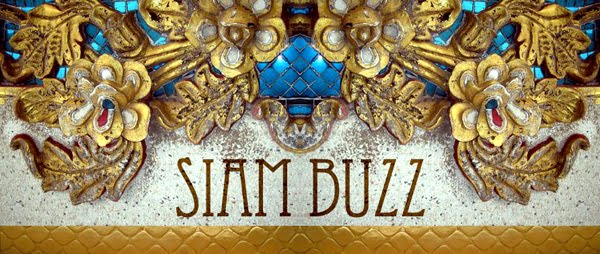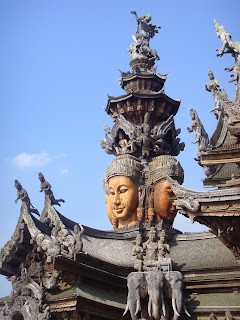When I first heard about this tourist attraction in Pattaya I was, I must admit, a little sceptical... It sounded like yet another cheesy, tacky, gimicky site that I could well afford to miss. However, being the thorough and inquisitive traveller/writer that I am I finally acquiesced and added it to Pattaya “to-do” list. And well, let me tell you, I was COMPLETELY wrong, this actually turned out to be the highlight of my trip!
The Sanctuary of Truth (also called Wang Boran and Prasat Mai) is a 105m-high wooden building of contemporary fantastic religious art that resembles a temple. It’s dramatically located on a rocky beachfront strip of land with thunderous waves lapping at its heels. When you arrive to the site you first take a somewhat uncomfortable and mortifying buggy ride from the main gate/ticket booth to the site itself; and rightly so, for who would want to walk a pleasant 150 metres through wooden parkland tsk tsk tsk! From here, at the top of the cliff, one can look down and get their first glimpse of the sanctuary.... Visible peaking about the tree line are some turrets and roofing, like the tip of an iceberg bobbing above the water. Many an involuntary gasp is uttered here, so the guide tells me, as the site truly is something otherworldly. One of those moments when the eyes do battle with the senses for control of the mind: what the hell is this?!
Construction begun back in 1981 and is scheduled to be completed in 2025. It has been initiated and sponsored by Lek Viriyaphant [1914-2000], an eccentric Thai millionaire and patron of culture who is also responsible for construction of the Ancient City and Erawan Museum. The sanctuary is in the style of ancient Khmer architecture like Angkor Wat in Siem Reap and is entirely covered in hand-carved wooden sculptures. It has four gopura (monumental halls) respectively representing images from the Buddhist and Hindu religion and mythologies of Cambodia, China, India and Thailand. The whole structure covers the area of more than two rai (just under 1 acre). It is being purposely constructed to withstand the wind and sunshine on the seashore at Rachvate Cape, Pattaya. I could have gleaned more nuggets of information from our enthusiastic guide who rattled through her prepared speech with military efficiency, but in truth I was so gobsmacked by the place that I paid scant attention.
According to the official website, the sanctuary’s purpose is to use art and culture as "a reflection of the Ancient Vision of Earth, Ancient Knowledge, and Eastern Philosophy. Within this complex, visitors will understand Ancient Life, Human Responsibility, Basic Thought, Cycle of living, Life Relationship with Universe and Common Goal of Life toward Utopia". Well, I don’t know about all the cosmic love, but it sure is a damn fine sight and worth a visit. For myself, I was quite blown away by the intricacy and workmanship that continues to go into the massive structure. Every section is truly unique and distinct and it’s captivating to see how amazing shapes can be carded out of wood and fastened together without using a single nail! When touring everyone must still wear a hardhat as worker bees are scrambling all over the place, underfoot and overhead, adding touches here and there. You can also inspect some of the carvers hard at work out back in the “preparation” shed.
Getting there: From the Siam Bayshore Resort & Spa or Siam Bayview Hotel you can easily get a car or moto taxi to take you there, about a 10 minute ride from the centre of town. The entrance fee is Bht 500 per person, which includes a horse and cart ride to/from the site, tour guide and dolphin (?) show.

































